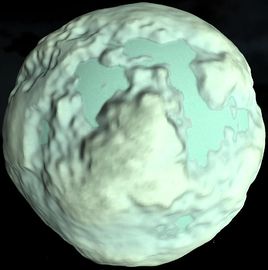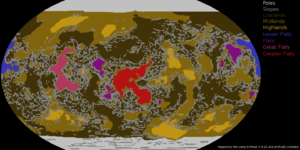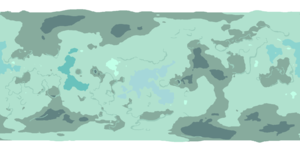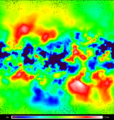Minmus
| Minmus | ||
| Minmus as seen from orbit. | ||
| Moon of Kerbin | ||
| Orbital Characteristics | ||
| Semi-major axis | 47 000 000 m [Note 1] | |
| Apoapsis | 47 000 000 m [Note 1] | |
| Periapsis | 47 000 000 m [Note 1] | |
| Orbital eccentricity | 0 | |
| Orbital inclination | 6 ° | |
| Argument of periapsis | 38 ° | |
| Longitude of the ascending node | 78 ° | |
| Mean anomaly | 0.9 rad (at 0s UT) | |
| Sidereal orbital period | 1 077 311 s | |
| 49 d 5 h 15 m 10.5 s | ||
| Synodic orbital period | 1 220 131.7 s | |
| Orbital velocity | 274 m/s | |
| Longest time eclipsed | 4 378 s | |
| Physical Characteristics | ||
| Equatorial radius | 60 000 m | |
| Equatorial circumference | 376 991 m | |
| Surface area | 4.5238934×1010 m2 | |
| Mass | 2.6457580×1019 kg | |
| Standard gravitational parameter | 1.7658000×109 m3/s2 | |
| Density | 29 242.046 kg/m3 | |
| Surface gravity | 0.491 m/s2 (0.05 g) | |
| Escape velocity | 242.61 m/s | |
| Sidereal rotation period | 40 400.000 s | |
| 1 d 5 h 13 m 20 s | ||
| Sidereal rotational velocity | 9.3315 m/s | |
| Synchronous orbit | 357.94 km | |
| Sphere of influence | 2 247 428.4 m [Note 1] | |
| Atmospheric Characteristics | ||
| Atmosphere present | No | |
| Scientific multiplier | ||
| Surface | 5 | |
| Splashed | N/A | |
| Near space | 4 | |
| Outer space | 2.5 | |
| Recovery | 2.5 | |
|
| ||
Minmus is the smallest moon of Kerbin. From the surface of Kerbin or the Mun, it is a cyan speck one or two pixels wide which appears to slightly oscillate vertically. This is a result of viewing its rotation from afar. Up close, it is off white in appearance with what seem to be icy buttes, large hills, and frozen lakes. The highest areas are over 5.7 km in altitude. It requires somewhat more delta-v to reach Minmus orbit than Mun orbit; however, it requires much less to land on the surface and return.
There is a tutorial about traveling to Minmus.
Contents
In-game Description
| “ | Minmus is the smallest moon orbiting Kerbin. From the surface of Kerbin, it can be seen on clear days as a tiny blue speck in the sky. It is often mistaken as dirt on the telescope lenses or dead pixels but the top minds at the Kerbal Astronomical Society assure us that it is a real moon never the less. |
” |
Orbital characteristics
Minmus orbits Kerbin at a continuous altitude of 46,400,000 meters and takes approximately 920 m/s Δv to transfer to from low Kerbin orbit. The synodic period from Kerbin's surface is 14 days, 3 hours and 1 second (1,220,401 seconds). A synchronous orbit around Minmus is possible at an altitude of 357.94 km.
It is important to be careful when attempting to return to Kerbin from Minmus, as Minmus' high orbit makes it very easy to escape Kerbin's sphere of influence entirely. However, this means that a base on or in orbit around Minmus would make a convenient refueling station for vessels leaving the Kerbin system.
Orbital speed around Minmus for an object with an altitude of 0 m is 171.5 m/s.
Surface Temperature
Calculation of the expected surface temperature for Minmus, using received energy from Kerbol, with the Stefan-Boltzmann Law for the radiated power gives a temperature of -50 degrees Celsius. Whilst this is lower than the measured value, it lends support to the theory that Minmus is a captured comet. It could not have formed at its present location but has an albedo high enough to prevent catastrophic sublimation of its icy composition. A high salt content, if present, would also slow the sublimation process.
This value of temperature was calculated using: An emissivity of 0.9 (close to but lower than compacted ice), an albedo of 0.6 (close to but lower than the real ice moon Europa), and the luminosity of 3 yotta watts for Kerbol. If the same calculation is performed for Kerbin with typical Earth values of emissivity and albedo, a temperature of positive 15 degrees Celsius is obtained.
Topography
Minmus has very divergent elevations. Plateaus at around 5 km high are matched by "Flats" at datum altitude (0 m). Much of the surface is transitional lowlands and highlands. With version 0.23, there are now 9 biomes.
The various "Flats" are almost perfectly flat and believed to have once been the site of liquid lakes. Minmus also has some mesas, one of which is near Minmus's north pole, that are so high compared to Minmus' sphere of influence that they count as "in orbit" according to the navigation tools. Unless the player manually switches the navball to Surface mode, this makes landing on these plateaus challenging, as the direction marker and speed will not automatically correct for the rotation of the surface.
For most landings which are not on a plateau or in a lake, the touchdown altitude is usually between 2000 m and 2500 m.
Jumping on this moon will make the kerbonaut ascend 10.4 m from the ground.
Taking a Surface Sample from Minmus says that it is a "crystalline substance, definitely not edible".
Biomes
Minmus has a total of 9 biomes. The most distinctive quality of Minmus's biomes is the variety of Flats, which in-game text describe as “lake beds”. They are almost perfectly flat and may represent salt flats. Roughly two-thirds of the surface area is irregular terrain transitioning between Highlands, Midlands, and Lowlands with Slopes in-between.
Biome list
|
Science
Although the science-multipliers of Minmus's surface and orbit are quite low compared to that of other planets and moons (but a little higher than Mun), Minmus is comparably easy to reach and to return from and has a very large number of biomes which all yield different science results. This makes it – together with Mun – the main source of science points during the midgame.
Reference Frames
| Time warp | Minimum Altitude |
|---|---|
| 1× | Any |
| 5× | 3 000 m |
| 10× | 3 000 m |
| 50× | 6 000 m |
| 100× | 12 000 m |
| 1 000× | 24 000 m |
| 10 000× | 48 000 m |
| 100 000× | 60 000 m |
Gallery
Trivia
- The name "Minmus" may be derived from the Latin word “minimus”, which denotes the smallest member of a group of beings or creatures, and is also the medical name for the smallest digit on the hand or foot. Minmus is the smallest member of the Kerbin system.
- It's also possible that Minmus is named after Saturn's moon Mimas.
- It's been speculated that Minmus was inspired by Haruki Murakami's book 1Q84, in which the protagonist discovers she is in an alternate-reality in part by noticing a tiny, moss-green moon in the sky next to the moon she knows.[1][2]
- It is possible to deorbit, land and ascend back into orbit around Minmus with the EVA jetpack starting at 100% fuel.
- If 2HOT Thermometer is used on surface, it shows a temperature of -0.007, which is just enough for water to freeze.
- If SC-9001 Science Jr. is used near or on Minmus in career mode, it will state that its test samples start to glow due to radiation. This might cause Minmus to have a higher temperature than Mun.
- Most, if not all, crew reports and EVA reports along with other experiments, may mention something about Minmus looking like a minty dessert. This may be a reference to the colour “Magic Mint” made by the Crayola company in 1990, and the colour itself looks almost exactly like that of Minmus's surface. This relation may be intentional; however, it may just be a coincidence.
Changes
- Biomes added.
- Minmus is no longer tidally locked to Kerbin.[3]
- Minmus' mass reduced.[4]
- Synchronous orbit is now possible. Previously, it would have required an altitude of 4 302.99 km, outside Minmus' sphere of influence.
- Initial release
See also
Notes
- ↑ http://forum.kerbalspaceprogram.com/threads/96074
- ↑ http://www.nytimes.com/2011/11/10/books/1q84-by-haruki-murakami-review.html
- ↑ http://www.reddit.com/r/KerbalSpaceProgram/comments/10q9z2/minmus_lost_its_tidal_lock_to_kerbin_in_v017/
- ↑ http://kerbalspaceprogram.com/forum/showthread.php/24156-Is-Minmus-on-a-weight-loss-program









